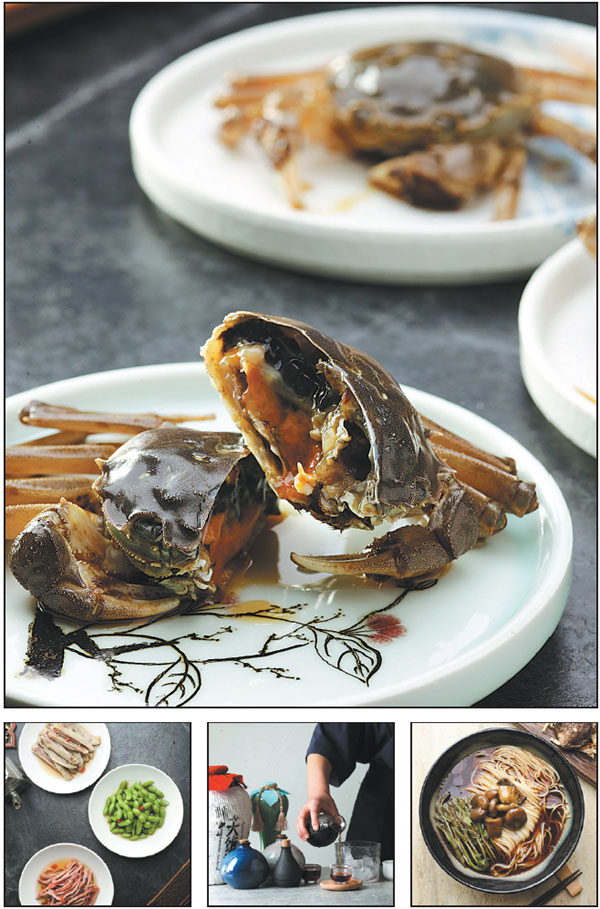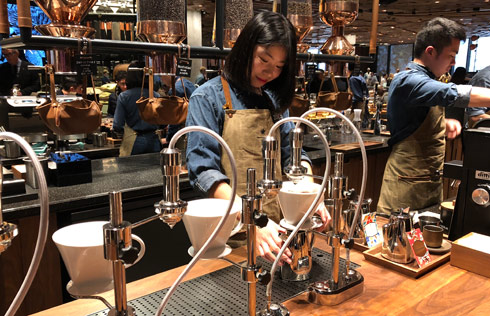Sating a crustacean fixation
With hairy crab season upon us, chef Wang Jianyong takes the opportunity to serve up his signature roe dish, where its unique flavor derives from its Shaoxing yellow rice liquor marinade, Li Yingxue reports.
The sixth month in the Chinese lunar calendar, usually August, is the best time to eat a particular type of hairy crab famed for its tasty roe - earning it the nickname of liuyuehuang, or "sixth-month roe".
At Shaoshisan, a Beijing restaurant specializing in Zhejiang and Jiangsu traditional cuisine, owner and chef Wang Jianyong is now serving Chinese mitten crab as part of his summer menu, together with authentic huangjiu, or yellow rice liquor, from Shaoxing, Zhejiang province.
|
Shaoshisan, a Zhejiang and Jiangsu traditional cuisine restaurant in Beijing, offers its seasonal drunken crab as part of its summer menu, together with a selection of the freshest summer ingredients with authentic huangjiu, or yellow rice liquor, from Shaoxing, Zhejiang province. Photos Provided to China Daily |
"The male crabs usually begin to fatten up in the second month (March, this year) of the Chinese lunar calendar, and now is the best time to eat them, when they weigh around 100 grams," says Wang. "The female crabs are left for several months more until their roe becomes tasty."
Live crabs are shipped daily to Beijing from Jiangyin, Jiangsu province, and Wang cleans them by placing them into cold water for four hours before he marinates them, still alive, in rice liquor for 24 hours.
"The secret to perfecting drunken crab's tasty flavor is to spray some baijiu (white liquor) onto them," says Wang.
The baijiu he uses is a type of huangjiu that has been twice distilled, which makes it transparent rather than yellow in color and gives it a higher alcohol content.
"The 'drunken crab' roe tastes like fancy ice cream," says Wang.
To pair with the drunken crab roe, a jar of Shaoxing huangjiu made from glutinous rice is a must.
Huangjiu is also one of the most popular features of "Jiangzhe" (Jiangsu and Zhejiang) cuisine, and diners at Shaoshisan are greeted by a wall of colorful liquor jars as they walk into the restaurant.
According to Wang, huangjiu has a history that dates back thousands of years and he believes that authentic huangjiu must use three ingredients: the water from Jianhu Lake in Shaoxing and the local glutinous rice and wheat, both harvested in season twice a year.
"The glutinous rice and wheat grown in northern China which are harvested once a year don't have the same sugar content or develop the same flavors as authentic huangjiu," says Wang.
Wang stocks three basic types of huangjiu at Shaoshisan, each using different proportions of rice and water to create different colors and flavors. As a general rule of thumb, the darker the liquor, the stronger the taste.
"Each year we start to make huangjiu in November at Shaoxing with freshly harvested grains and it keeps on fermenting in jars until the following April or May. The longer the ingredients ferment, the richer the flavors become," says Wang.
Wang also serves his customers a special huangjiu named Dafan, which is a blend of three types of liquor which presents a more well-rounded flavor.
The 53-year-old Shanghai chef moved to Beijing in 1994 and started cooking Shanghai cuisine, which is essentially a combination of Huaiyang and Cantonese cuisine.
After having spent two decades as the executive chef at the Jiangzhe cuisine restaurant chain, Kongyiji, Wang opened Shaoshisan in 2017 to focus on his love for fresh ingredients and authentic flavors.
"There is nothing more important than eating," says Wang.
In the Wu dialect (native to Jiangsu and Zhejiang), "shisan" means someone slow or honest. Wang named the restaurant Shaoshisan to reflect the restaurant's spirit of integrity. He added the word "shao" to represent Shaoxing.
Besides the drunken crab, Wang's summer menu also highlights the freshest seasonal ingredients and presents their authentic flavors without the use of heavy seasoning.
Pickling is another signature of Jiangzhe cuisine, where a range of ingredients are marinated in huangjiu together with condiments and distillers' grains, before being packed into jars and left to ferment.
Each region of Jiangsu and Zhejiang province has its own special ingredients they like to pickle: chefs in Shanghai use green soy beans, while in Ningbo and Shaoxing they prefer chicken or goose.
Wang recalls when he was young, to celebrate Spring Festival, his family would prepare several kinds of pickled dishes. One recipe involved placing a deboned, boiled chicken or goose coated with salt into a jar, then covered with layer after layer of ingredients separated by distillers' grains. Half a month later, the food was ready to eat.
According to Wang, any common ingredients can be marinated using huangjiu, from meat to vegetables.
Wang's signature dishes at Shaoshisan include marinated chicken, goose and green soy beans.
Marinated bamboo shoots are a must-try as the first bunches are harvested in spring. Wang boils the tender bamboo shoots with some condiments and marinates them in a special brine at under 10 C for a week. The bamboo shoots are then packed so they can be kept for the summer.
Served in July, they taste just as tender as fresh bamboo shoots.
"Once the bamboo-shoot season ends, we serve cane shoots to ensure our diners can enjoy the dish all year round," says Wang.
Wang goes to great lengths to serve up the freshest ingredients during the harvest season. For his summer menu, he serves up white lotus root from Mata Lake in Shandong province and fresh lotus seeds - both are so delicious they are served uncooked.
The white lotus root is crunchy, glutinous and sweet, while the lotus seeds are slightly bitter with a sweet aftertaste.
Besides creating dishes according to the season, Wang is also an aficionado of the traditional feasts unique to the Jiangzhe region.
The long fish feast is one such traditional meal from Jiangsu province which uses eel to make a staggering 108 different dishes. Wang hopes to replicate this ancient feast for his customers, which is recorded in the annals of Qing Dynasty (1644-1911) history.
Contact the writer at liyingxue@chinadaily.com.cn
(China Daily Global 08/02/2019 page16)



















